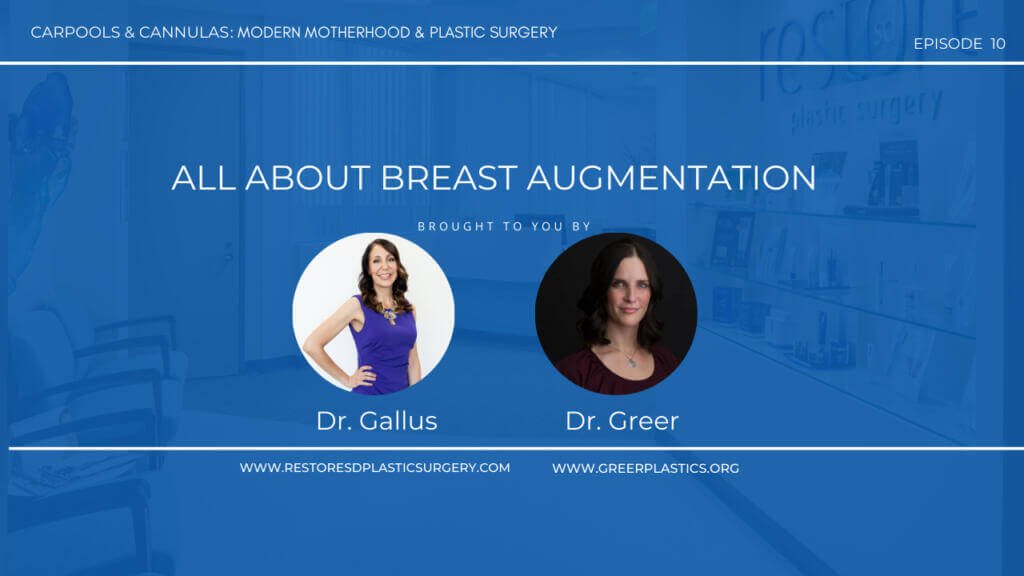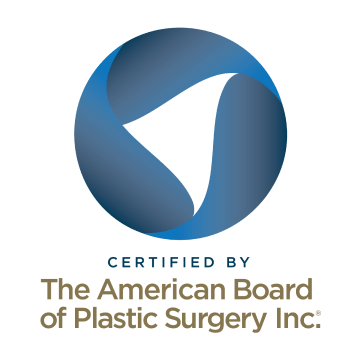On this episode of Carpools & Cannulas: Modern Motherhood and Plastic Surgery, Drs. Gallus and Greer discuss breast enhancement surgery. They chat about all the choices you make when deciding to have breast augmentation and why it is important to have a board certified plastic surgeon.
Transcript
Dr. Gallus: Hi, everybody. I’m here to do another episode of “Carpools and Cannulas.” Took me a minute to get an internet connection, weirdly. But we are here, and Dr. Greer is going to join me in two seconds, which is awesome. Right on time. See if she’s coming on. Ah, there you are. Perfect.
Dr. Greer: Hello.
Dr. Gallus: Hi. Happy Wednesday.
Dr. Greer: How are you? I know.
Dr. Gallus: I’m good.
Dr. Greer: Happy Wednesday.
Dr. Gallus: I feel like there’s struggle getting on live. Like, I hit one button, and then it doesn’t do, and then I’m just, like, staring at myself. Is it on? Is it on?
Dr. Greer: I know. Yeah, I do that too. Or I’m, like, the queen of one more thing. I’m like, “I can do this one, I can wipe down the counters. I can fold this laundry,” and then I’m late. And my OR day starts at 8 a.m. instead of 7:30.
Dr. Gallus: Because you can get one more thing done. Always. My husband and I differ on that, especially when it comes to traveling. So his name is Dave, and we have a nickname for him when we travel and we call him Airport Dave because he’s like…
Dr. Greer: He likes to get there super early and hang?
Dr. Gallus: Yeah. Doesn’t want to miss anything. And I’m like, “But I can go get coffee,” or, “I can…” “No, you’re gonna miss the flight.”
Dr. Greer: I know. I should channel him. Last time we took a family trip, we literally were sprinting for the gate, and we were the last people on. They overhead paged us.
Dr. Gallus: That’s his claim to fame is like he’s never missed a flight. So it was like, okay.
Dr. Greer: That’s all right.
Dr. Gallus: So I can’t believe it’s Wednesday again. Look at all these people joining us.
Dr. Greer: I know. Hello, everyone.
Dr. Gallus: Hey, man.
Dr. Greer: We love that you’re here.
Dr. Gallus: Thanks for joining. So we’re gonna talk about boobs tonight, right?
Dr. Greer: Our favorite. We were both sending each other, like, the little smiley emojis with the heart eyes because we love doing breast surgery. It’s my favorite.
Dr. Gallus: So I thought we could kick off with just a breakdown of the different kinds of implants. I’m not sure if we’ve even covered that for breast augmentation.
Dr. Greer: I don’t know that we have, and they’re worse… So implants started ages ago, before the FDA was created even, which is fascinating to me. There was a great book on silicone breast implants. I forget what it was called, but it went through the whole history. And silicone were the original implants. And then they came off the market briefly after requests for more data. And at that point, you could only get saline. And then silicone have been back on the market since, what? 2010?
Dr. Gallus: ’06, I believe.
Dr. Greer: Oh, ’06, okay.
Dr. Gallus: So there was like a 10-year period where you couldn’t get it. And then most of those patients have saline implants, that chose to have augmentation here. And I would say the other category, people with saline implants are silicone’s technically FDA-approved for 22 and older. So people who do a lot of 18 to 21-year-old patients, I think, tend to do saline, although you can put silicone in those patients as well.
Dr. Greer: Yes. So it’s just an off-label use. The only real concern I have with that is whether the company will cover the warranty since it’s an off-label use.
Dr. Gallus: Correct. And I have gotten mixed feedback on that. But luckily, I never had to make the choice for anyone. So it’s been nice. But I did take care of somebody who had silicone implants put in. And then when we were thinking about revising, doing a revision, the company did push back because they had been put in under 22. So that was kind of a bummer. But she elected to take them out anyway, which brings me to my, like…I think the primary thing about implants is that they’re not lifetime devices, no matter what kind you choose.
Dr. Greer: This is literally every implant talk I do. I’m like, “Okay, let’s talk about breast augmentation. These are not going to last you forever.”
Dr. Gallus: Right. But the same rumor mill that suggests that they’ll last forever, and you’ll never need to deal with them again, is the same concept that at 10 years, you’re going to need to take them out, and do something with them and exchange them.
Dr. Greer: Right. And it’s not an oil change. It’s more like a good roof. Yes, the average lifespan is 10 to 15 years. But if it’s not leaking, you don’t have to replace it.
Dr. Gallus: So occasionally, people come in for different reasons, and then they’ll be like, “So I also have implants and I’m just wondering, you know, I’m heading on 10 years.” And I’m like, “Yes, you’re good. Unless, do you have a problem?” “No, I don’t have a problem.”
Dr. Greer: So the interesting thing, the biggest difference between saline and silicone, of course, is if silicone has a rupture, you know, the breast deflates…or not silicone, rather, if saline has a rupture, the breast deflates. With silicone, you don’t always know, especially the cohesives, and they do wear out more at 10 years. Do you do any routine screening? I know the FDA recommends every two years, starting three years out… Oh, hey, Aaron. I was kind of wondering where you were. But it’s not, like, based on any actual data.
Dr. Gallus: No, yeah. So I see plenty of women who have maybe a saline rupture noted on mammogram, their screening mammogram. So I don’t tell people that they have to. I feel like the FDA is in the process slowly of changing that recommendation for an MRI every three years, because nobody can do it. It’s not covered, it’s expensive, it’s not a guarantee.
Dr. Greer: Yeah. There’s not a proven benefit either.
Dr. Gallus: Right. And I think the thing that bugs me the most about that is that if you do an MRI, if you just write MRI to check implants versus MRI to screen for breast cancer, they’re two different things. And so just because you had an MRI to check if your implants were intact does not mean you got a clean bill of health from a breast cancer standpoint. So they have to, like…
Dr. Greer: Right. They don’t evaluate it the same way.
Dr. Gallus: Yeah. So, if it did that, then I’d be like, “Sure, because you get an extra breast screening, and, like, MRI, in some areas, is a gold standard.”
Dr. Greer: Well, the other interesting factor is that ultrasound is very effective for screening for rupture.
Dr. Gallus: And it used to not be. So we were relying on the technology to catch up. And I think now that the…
Dr. Greer: High-resolution.
Dr. Gallus: …high-res, yeah, technology is catching up. Same, that’s when we had at the last Women Plastic Surgeries in-person conference in Nashville. We had a demo and a radiologist come talk to us about all that. And it was this concept. So you can order an ultrasound to screen for implant ruptures. But also that does not count as your mammogram for the year, like, that’s not a screening study for breast cancer.
Dr. Greer: Right, because ultrasounds are targeted. The mammogram is looking at the entire breast. Ultrasound is only if they see something specific to look at, or if you have a palpable mass. It’s a targeted study. The other interesting thing is ultrasound is now becoming widely available in offices. I actually just got my ultrasound last week.
Dr. Gallus: Oh, you did?
Dr. Greer: So this was a very timely talk. Yeah, I got the butterfly, which is a high-resolution ultrasound. It plugs into my iPhone, which is amazing. And I got it with the intent of just checking in on all of my breast-aug patients, so that we can follow them long-term without having to send them to radiology for formal studies.
Dr. Gallus: That’s awesome. You’ll have to let me know how it goes. I’ve not pulled the trigger on that. Does it come with a course so that you can check imprints?
Dr. Greer: It has a lot of modules on it. I have looked at a lot of the ultrasounds that have been shared through, like, the talks with ASPS. And I think it was Pat McGuire who was sharing some. But the overall recommendation, I heard, was just like when we’re learning to read CTs and chest X-rays, it’s just look at a ton of them. So right now I’ve been ultrasounding everybody who has implants. If you come near my office, then you’ll get ultrasounded. By the way, I looked at my own kidneys. This thing is really good.
Dr. Gallus: Oh, it’s that good.
Dr. Greer: You can do, like, FAST scans, you can do echocardiograms, the resolution’s very good. So I’ve just been looking at everybody’s implants with the caveat of, “I’m not a radiologist, I’m just learning.” I did have a patient whose implants were 10 years, and I said, “I’m happy to look at them for you. But if there’s any concern, we’re gonna just order an ultrasound and have a radiology read,” which we ended up doing because I couldn’t tell her for sure that they were not ruptured. You know, the implants that are like three and four years out, I’m just looking to see what they look like at this point.
Dr. Gallus: And then maybe you’ll find somebody who comes in with a known rupture and you can check it, too, right?
Dr. Greer: Exactly, exactly. And that’s, you know, after the learning curve, I think it’s going to be very, very helpful. The other nice thing is I saw a patient today who had had implants removed and was worried that maybe she had thickened capsule. And, you know, it’s very easy to see the homogenous density of breast tissue and no seroma. So that was nice. I thought it was gonna take a lot longer to ultrasound people and, like, you just whip it out, plug it into your phone… I see your puppy. She has a sweater.
Dr. Gallus: I know, because I live in Southern California and it’s gloomy.
Dr. Greer: So he’s cold.
Dr. Gallus: So the kids put a sweater on her. It’s, you know…
Dr. Greer: That’s adorable.
Dr. Gallus: …70 degrees. So they were worried about her.
Dr. Greer: That’s reasonable. But I have to say, like, I didn’t pull the trigger on it for the longest time because I thought it was gonna add all this extra time in office. I think I ultrasounded four people today just because I could. And…
Dr. Gallus: It wasn’t…
Dr. Greer: Yeah. It, like, took two minutes and it was nice to be able to look and get views. And some were like…I think I had a six-month implant patient. It was just like, “Let’s see what these look like so that we know, and then next time we’ll check them.” I think it’ll be really useful for people.
Dr. Gallus: That’s great. I’ll have to look into it. It’s on my, like, laundry list of things to do.
Dr. Greer: Yeah. I mean, compared to the old technology of a $45,000 cart on wheels, now, it’s like a $2,000 probe. Hi, Ella. Do you want to say hi? Oh, here, lean over. There you go. Okay.
Ella: Mom, can I have a piece of gum?
Dr. Greer: Yeah, go ahead and have a piece of gum.
Ella: Thanks.
Dr. Greer: Okay. We extended the kids’ bedtime to 9:30. So you’ll probably be seeing them a lot more.
Dr. Gallus: It’s summertime, huh?
Dr. Greer: Yeah. Well, and honestly, they’re just 5 and 7, 8:30 is not really a time when they fall asleep anymore.
Dr. Gallus: We’re in summertime mode, too. So everyone stays up late.
Dr. Greer: Love you.
Dr. Gallus: Sometimes later than me.
Dr. Greer: I know, right? I’m, like, falling asleep at 9:00 and they’re…
Dr. Gallus: They’re like, “Oh, can we stay up later?”
Dr. Greer: Yep. But then the next morning, they’re like-
Dr. Gallus: “Go to your room.”
Dr. Greer: Exactly, exactly. Oh, different types of implants. We kind of glossed over saline versus silicone. People always ask about gummy bear implants. And really, I think most of the silicone implants on the market now are a cohesive gel because that’s…
Dr. Gallus: They all are.
Dr. Greer: Yeah, that has become the new standard of care. If you cut it in half, it’s going to hold its shape, at least while it’s new. Ten years down the road, that silicone may change a little bit. But the other big type, people ask about the anatomic. Those are a little hard to get now because the other big implant division was smooth versus textured, which has to do with the shell. And if it has a really fine, pebbly texture, the idea there was to keep it from displacing. And for the anatomical or teardrop implant, you need it so that they don’t rotate. But the risk with those is a very minute increased risk of anaplastic large cell lymphoma.
Dr. Gallus: Correct. So there’s three major implant companies that do silicone implants, and one of them had pulled off their shaped implants off the market. That’s Allergan. The other two are still available. I was surprised somebody asked me about anatomics the other day and I was like, “Oh, I don’t do those because there’s too much risk.” To me, it’s not worth the risk of having textured implants and having a problem down the road. So stick with smooth.
Dr. Greer: And the smooth, you know, when you hold them up, the gel settles into a teardrop shape. They look fantastic. They feel very natural.
Dr. Gallus: Which is the other major difference between silicone and saline is feel. Oftentimes, you can’t tell what somebody has just by looking at them. But you definitely feel the difference. If you have very little breast tissue overlying, you can tell the difference between a saline implant. Then do you have much experience with Ideal Implants? So there’s another type of implant.
Dr. Greer: That’s right. Let me think. It’s a silicone center with, like, a saline surround that you can adjust. So it’s supposed to –
Dr. Gallus: No, that was…
Dr. Greer: Or is it backwards? I forget.
Dr. Gallus: Actually, it’s totally saline.
Dr. Greer: Oh, but it’s supposed to feel like silicone?
Dr. Gallus: Yeah, it’s a double saline.
Dr. Greer: I’ve never actually used it. And I’ve heard…
Dr. Gallus: Mixed reviews?
Dr. Greer: Yes.
Dr. Gallus: I haven’t used it either, although I have offered it. I just haven’t found the right person for it. I just feel like if you’re really concerned about the feel, then you’re just gonna go with silicone.
Dr. Greer: Get silicone. Exactly.
Dr. Gallus: There used to be…I think it was the Becker adjustable implant, that was a silicone implant.
Dr. Greer: That’s what I was thinking. It’s double-lumen.
Dr. Gallus: You’re too young for that.
Dr. Greer: I’ve taken one of those out. I’ve taken them out. Yeah, I didn’t use them, though. My predecessor used them. But I think, you know, with silicone, the only reason I ever have people ask for saline is if they want to know that it ruptured. And I think with the growing availability of in-office, high-resolution ultrasound, patients are going to be much more reassured that, “Hey, I can go in once a year and get it checked. No big deal.”
Dr. Gallus: Yeah, I did…actually, there used to be an adjustable saline implant. I’m not sure if it was the Becker or not. But it had a little remote port. And so you would put the implant in, and then you could fill it more or take some volume out, just like an expander, afterwards. And the patient I had had had them done in Hawaii, like, a couple of years earlier, but never went back to get the port out. So she’s still had the port in place.
Dr. Greer: That’s so funny.
Dr. Gallus: It was very random. But, yeah, they don’t make those either. I like the concept though. Like, we’re gonna put these in, and if you want to be a little bit bigger, we can just in-office add more. Like, not a terrible concept, but anyway.
Dr. Greer: No. I mean, it’s really not but… And that’s another common question is like implant size. And there’s this…kind of it’s like a myth or, like, just advice passed down that you should always go a little bit bigger because you’re gonna be sorry if you don’t. And I’m told that by so, so many patients. Do you hear that a lot, too?
Dr. Gallus: Yeah. Well, what I do see a lot is women who are further along and are ready to exchange their implants are like, “Listen, we had a conversation. I said I wanted 250cc implants or I just wanted a lift. And then I woke up and I had these 400cc implants in. And I was told…”
Dr. Greer: I hear that so often.
Dr. Gallus: I know. “And I was told by the surgeon that they just looked better and it fit my body better,” or whatever. And I’m like, “Okay, well, no. We need to come to an agreement on what size implants you’re going to put in before surgery. I’m not going to do a, “Oh, I just thought another 50 or 200ccs was…”
Dr. Greer: Only true about diamonds. Yes, bigger is fine there. With implants, it’s like, why would a woman not know her own body and know what size she wants? That drives me bonkers.
Dr. Gallus: That happens all the time.
Dr. Greer: I did actually survey a bunch of my aug patients, just out of curiosity, to see if they were, like, perfectly happy or if they initially thought it was too big or too small. And it turned out, like 70% of women ultimately love the size they chose. Like, maybe initially, they thought it was too big or too small. And then when things settled, they were really happy. And then, like, 20% wished they’d gotten bigger, and like, 10% wished they’d gone a little smaller. So by and large, the majority of women pick a size that they are happy with.
Dr. Gallus: So we decide on the type of implant, which we talked about, saline versus silicone, the incision, which we can talk about, the pocket location, which we can talk about, and then the size. Everybody focuses on the size. And sometimes I have people like, you know, pulling their hair out because they can’t decide between a 345 and a, you know…
Dr. Greer: Three sixty-five?
Dr. Gallus: …three sixty, yeah. And I’m like, “It’s a shot glass. So don’t beat yourself up over it. It’s literally this much volume.”
Dr. Greer: Right, I tell them… If I have a patient sitting up and I have 30ccs more on one side, I have to really use my discerning surgeon eye to tell which side that is. So once they get into, like, 60 to 100cc range, I’m like, “You’re gold. You’re going to be happy with anything you choose here.”
Dr. Gallus: And I even had somebody who wanted to exchange and she couldn’t decide between, I feel, like, 425 and 450. And her husband was like, “No matter what you choose, you’re gonna overthink it and then be sad.” And so she already had implants in place.
Dr. Greer: Sounds like he knows her really well.
Dr. Gallus: So it wasn’t even that hard. So what they came to me with is, “We want you to put in one of those two sizes,” which, like I said, doesn’t matter, “and then put the implant card in an envelope.” It’s like knowing the sex of your baby. And then that way, when I feel like I want to check that or give it to her husband, and then once she wants to know, she can check it later.
Dr. Greer: Did you do it?
Dr. Gallus: Yeah, I did that. I was like, “Okay. Let me know if you wanna know.”
Dr. Greer: How did you decide which one to use? That’s so funny.
Dr. Gallus: It was a little bit based on, like, what she had in there, too. So, like, sometimes people are like, “I wanna be a skosh bigger.” “Oh, okay. Well, what do you have?” “I don’t know.”
Dr. Greer: No idea. So then you’re kind of guessing.
Dr. Gallus: “Okay. Well then, it’ll be a mystery until I pull one out and say, ‘Oh, it’s a 400. Okay, we can do 400.'”
Dr. Greer: And you just order a bunch. You’re like, “Okay, yep, we can go up a little bit.”
Dr. Gallus: Yeah. There is a lot of anxiety about the size, and then it ends up just being…it’s like, they’re…
Dr. Greer: Like, they’re happy with it most of the time.
Dr. Gallus: I know. I wonder if they ever opened it. I don’t know. We saw her, like, at six months and then… I just didn’t want to bring it up because it was such a hot topic. It’s like, you don’t want to be the one who’s like, “Oh, you’re having a girl. Oh, you didn’t want to know. Sorry about that,” you know?
Dr. Greer: That’s funny.
Dr. Gallus: So let’s talk about incision location. We have a few minutes left.
Dr. Greer: Absolutely. I do inframammary. I always do inframammary. Exception being if somebody has tuberous breasts, which is where the lower pole is constricted and the crease is higher, and usually the medial aspect of the breast is a little narrow, then I will do an incision around the areola, so I can release the breast tissue and allow that to stretch. But other than that, I always do inframammary because it’s a great scar. It hides so well.
Dr. Gallus: I agree. I don’t like going periareolar unless the patient already has that incision and I’m doing an exchange. Skosh…
Dr. Greer: It’s a word. It’s a word. I thought it had a T-S-H.
Dr. Gallus: I feel like it’s a medical term. So I think that hides the best, unless they already have that incision. And even then, I like, try, to stay out of it because if you go back and see people who have had breast implant removal, it’s not…
Dr. Greer: It can indent.
Dr. Gallus: Indent. And it doesn’t have anything to do with it. It just does that. So I do prefer inframammary crease. I’ll use vertical access if I’m doing a lift at the same time, which is a whole other conversation. I’m not gonna make a whole brand-new incision if we’re using, you know, a lollipop lift. And then pocket location, we’re gonna have a panel on this, the upcoming Women’s Plastic Surgery retreat in February. We’re gonna, like, do some dueling, you know, submuscular and then subglandular. But I do mostly submuscular, like 99%.
Dr. Greer: Ditto. And then there is the subfascial which is under the pec fascia. And there are some diehard subfascial fans, too. Oh, and just so we cover the other incision types, there’s periareolar. But there’s also a lot of proponents of the axillary incision, where it’s like up hidden in your axilla. I know a couple of people who do that, and it’s kind of a niche thing because there’s no scar in your breast. I personally don’t get it because, at some point, you’re gonna have a scar on your breasts when that implant comes out. They do not take it out through your armpit. And if you’re wearing a tank top, the incisions’ totally visible.
Dr. Gallus: I don’t love that incision. I actually have taken a pair out through the axilla because nobody else offered to do it.
Dr. Greer: How was that?
Dr: Gallus: It was not as hard as I thought it would be.
Dr. Greer: Oh, that’s good.
Dr. Gallus: But I think if you’re not doing it endoscopically… So when I trained, I worked with a guy who did a ton of saline implants transaxillary, and it was what we call blind technique. So they would make the incision…
Dr. Greer: And then just put a dissector down and…
Dr: Gallus: Yeah, and, like, make the pocket. And I was like, but…
Dr. Greer: I mean, I’ve seen it. I know some people who do it endoscopically, so they have a camera they’re looking. But I think the reason I hate it is I remember once having drinks with somebody in a bar and I saw her incisions. And, like, the fact that I can tell that you had a breast-aug when you’re fully clothed in a bar, to me just seems like not what I would go for.
Dr. Gallus: Right. Oh, the TUBA, mentioned only to be dismissed as an option.
Dr. Greer: I had a friend who had a TUBA.
Dr. Gallus: Did you, really?
Dr. Greer: So it’s transumbilical breast augmentation, by the way, guys. I actually saw that on, like, The Learning Channel in college and I was like, “Really?” So you go through the belly button. But you can only use saline implants because you can’t shove a silicone implant up there. It’s a long dissection so you’re going blind. And they can only go above the muscle. There’s a lot of downsides to it.
Dr. Gallus: There’s so many downsides. TUBA, we just…so transumbilical breast augmentation, go through the belly button. The one time I’ve seen it done was actually watching “Dr. 90210” back in the day before I was a plastic surgeon. But I think it might have been…I don’t know, I knew enough to know, he did a tummy tuck. So he’d raise the abdominal flap, and then went through the abdominal flap to do it. And I was like, “Again, that isn’t actually a tuba. That is…I mean, you’re now just going through the abdomen.” That’s so bananas. It wasn’t even. I was like, “He can’t even get that right.” It was terrible.
Dr. Greer: That would be like a TABA, transabdominal breast augmentation.
Dr. Gallus: Which also is not a great plan. You can’t see.
Dr. Greer: It’s just you don’t get very precise… No, you can’t see anything. It’s funny, like, the people who seem to worry about scars on the breast are, by and large, men. I mean, women worry about the lift scars because they’re on the front. But that inframammary crease scar, like, you were not gonna see it unless you have a mirror, and no one else is gonna see it unless you are standing above them naked. And if that is your job, or your job involves that, or that happens regularly, I mean, you know, I don’t think that’s a huge surprise that you had an augmentation.
Dr. Gallus: Right. That’s your line of work. It’s not gonna… And I feel like the incision just heals well, and it’s pretty simple.
Dr. Greer: Oh, it hides beautifully. Like, I’ve seen women 10 years out where you are struggling to find that scar.
Dr. Gallus: A hundred percent. Where you’re like, “Where did you have this done? I gotta find the incision.”
Dr. Greer: Exactly. You’re like, “Wait, I wanna go through the old scar, but I gotta find it.” It’s just, like, no need to overcomplicate things.
Dr. Gallus: So, like I said, I do most of mine submuscular because I think it holds the implant up well over time.
Dr. Greer: Ditto.
Dr. Gallus: And I have not played around with subfascial. I’ve looked, I check when I’m there to see, like, what’s the fascia look like? Can I do this? And I’m sometimes underwhelmed by what the fascia looks like.
Dr. Greer: It’s not as thick layer. It’s really not.
Dr. Gallus: So I feel like it’s mostly subglandular still.
Dr. Greer: I mean, it’s something that I would definitely recommend if you’re doing top surgery for male to female. Because the pec muscle is so strong, you can really get a visible animation of the implant. And most women, like, you flex your pecs and it’s like, “toop.”
Dr. Gallus: Right. And I feel like men have a thicker pec fascia as well. Because when you’re doing gynecomastia, you can definitely see it. When you do that surgery, you’re like, “Oh, that’s there.”
Dr. Greer: So with that, the implant can settle a little bit better. But there’s also the total submuscular also known as the Holly Dawn technique because she has popularized it. And that’s not one I’ve tried yet either. I’ve definitely released less of the pec where… So your pec muscle inserts on your sternum in the midline, and then on your ribs just for a couple of centimeters. And normally, we’ll release it all the way to the sternum so that the implant can settle. But sometimes I’ll leave some of those medial fibers intact, especially if it’s a larger implant that needs support, but only if I’m doing a lift or they really have no ptosis at all. Because you don’t want the breast dropping off the implant. That’s not a good look.
Dr. Gallus: So I have tried adding that in a little bit as well. But it’s in the right patient. And what I like about, though, trying to stick with that concept is that there’s almost no lateral dissection, which, I think the less you expand that lateral pocket, the better off the patient is over time, because everyone hates when your implants start moving…
Dr. Greer: To the side.
Dr. Gallus: …off the chest. Yeah. And I tell people, like, “Your chest is not a table, you know, it’s concave.” And so everyone’s breasts will…you know, if you see somebody with naturally large breasts, when they lay down, they move to the side.
Dr. Greer: They fall to the side. Well, and you know, that brings up the topic of implant profile, which we haven’t talked about. And I find patients who are either hyper-aware and they’re like, “I want this profile,” or they have no idea what it is. So implant profile is basically how big the base diameter is for a given volume of implant. So higher profile implants project more off the chest. And this actually isn’t something patients need to choose, we choose it. During the exam, we measure the width of your breast. And then when you pick the volume, we match up the volume with the base diameter that fits your breasts. But the thing is, once you get into the, like, 600, and 700, and 800-milliliter implants, yeah, we do need to… There’s a lot about breasts. We could talk about breasts forever.
Dr. Gallus: There’s so many different kinds of implants. So… Oh, my god.
Dr. Greer: But that’s the thing. Like, if you want a really big implant, you’re going to have sideboob and it is going to stick out. And that’s something that’s really important to understand. Because I have a patient who doesn’t love the side boob but she loves the size. And I was like, “You know, we can close out the pocket there. But we’re gonna have to go down like 150ccs in size,” because the chest is narrow on some people.
Dr. Gallus: So I do adjust. If they want a certain volume, I’ll adjust the profile to get that volume in here.
Dr. Greer: Can I help you, love?
Ella: I want to snuggle with you.
Dr. Greer: Okay, I will come snuggle in a bit. We’re almost done, okay?
Dr. Gallus: You have one minute.
Dr. Greer: One minute. We’re almost done and I’ll come snuggle. Okay. Don’t burp. Gross.
Dr. Gallus: And you’re not selling the snuggling if you burp. Of course, my kid is chit-chatting with my nephew.
Dr. Greer: I saw. I was like, “Oh, Bella, there we go. That’s fine.”
Dr. Gallus: So they’re just reaching out to me remotely from downstairs. That’s awesome.
Dr. Greer: That’s awesome. Wait till they start messaging like, “Mom, I want gum. I want snuggles.”
Dr. Gallus: “Can you come downstairs for a second?” So, good session. I feel like there’s more to talk about breast augmentation.
Dr. Greer: Always.
Dr. Gallus: We can break it down in another session.
Dr. Greer: I mean, yeah, we can talk about it next time, maybe, and talk about, like, recovery because that’s a really good topic. And there’s lots of fun little tricks to help people… Oh, thank you for saying we’re amazing.
Dr. Gallus: Thanks, Sally.
Dr. Greer: But, yeah, that’s one of those things where people are really afraid of their recovery. And then most of my patients are like, “Oh, that was not awful.”
Dr. Gallus: We can definitely talk about that. So maybe we’ll talk about the actual surgery, like, what to expect that day, and then recovery.
Dr. Greer: Fabulous.
Dr. Gallus: So next session. I feel like these two weeks come up faster than I expected. I had to, like, look at the calendar again.
Dr. Greer: I know. I was glad you did. I, for some reason, didn’t even put it in my calendar. But I was like, “I think it’s this week.”
Dr. Gallus: So all right. Yeah, I know it’s Erica posing as Ryan, but I swear he was on there for a second saying hi to Bella, or maybe not. You might be right. The diamond comment? Yes. All right. Well, go snuggle, Jen…
Dr. Greer: I will. Good to see you, Kat.
Dr. Gallus: …and I will go make sure dinner didn’t get burnt.
Dr. Greer: Fabulous. See you in two weeks.
Dr. Gallus: Okay. All right. Bye, everybody. Thanks for joining.
About Restore SD & Dr. Katerina Gallus
As the Director of Restore SD Plastic Surgery, board certified female plastic surgeon Dr. Katerina Gallus has over 15 years of experience helping San Diego women enjoy head to toe rejuvenation with face, breast and body procedures. After a successful career as a Navy plastic surgeon, Dr. Gallus founded Restore SD Plastic Surgery with the intention of creating a welcoming space for anyone seeking cosmetic enhancement.
Restore SD Plastic Surgery offers popular facial rejuvenation procedures like facelift & neck lift, facial fat grafting, and eyelid lift; breast augmentation with implants, breast lifts or breast reduction; body contouring procedures such as tummy tuck, liposuction, mommy makeover, and Brazilian butt lift (BBL), as well as aesthetician services, BOTOX, injectable fillers, and laser treatments.









